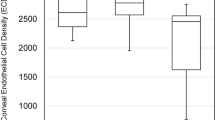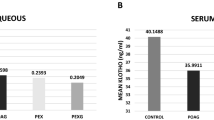Abstract
Purpose
This study investigates the relationship between plasma homocysteine levels, anterior chamber depth (ACD), and pseudoexfoliation glaucoma (PEXG) in patients with pseudoexfoliation syndrome.
Methods
Sixty patients (F:M = 35:25) with pseudoexfoliation (PEX) were divided into two groups based on their plasma homocysteine levels; group 1 (< 20 µmol/L, normal) and group 2 (≥ 20 µmol/L, high). Intraocular pressure (IOP) and ACD values as well as plasma homocysteine levels were compared between the two groups. Moreover, the mean values for ACD and IOP were compared between patients stratified according to the reference upper limit for the homocysteine level (above and below 14 μmol/L), and the prevalence of high IOP was estimated.
Results
Groups 1 and 2 showed no statistically significant differences in the mean ACD (3.04 ± 0.28 vs. 3.07 ± 0.31 mm, respectively) and mean IOP (20.63 ± 10.22 vs. 21.67 ± 7.55 mmHg, respectively). Patients with PEX and homocysteine levels > 14 μmol/L had a significantly increased prevalence (P < 0.05) of high IOP (≥ 22 mmHg).
Conclusions
Patients with PEX and high homocysteine levels have an increased prevalence of high IOP. No relationship exists between plasma homocysteine levels and ACD. Thus, PEXG should be suspected in patients with PEX and high plasma homocysteine levels. Plasma homocysteine levels could be helpful for the diagnosis of PEXG, although larger sample studies are required to confirm this finding.



Similar content being viewed by others
References
Tranchina L, Centofanti M, Oddone F et al (2011) Levels of plasma homocysteine in pseudoexfoliation glaucoma. Graefes Arch Clin Exp Ophthalmol 249:443–448
Bowling B (2016) Kanski’s clinical ophthalmology: a systemic approach, 8th edn. Kennedy Boulevard, Elsevier, Philadelphia
Rebecca M, Gayathri R, Bhuvanasundar R, Sripriya K, Shantha B, Angayarkanni N (2019) Elastin modulation and modification by homocysteine: a key factor in the pathogenesis of Pseudoexfoliation syndrome? Br J Ophthalmol 103:985–992
Turkcu FM, Koz OG, Yarangumeli A, Oner V, Kural G (2013) Plasma homocysteine, folic acid, and vitamin B12 levels in patients with pseudoexfoliation syndrome, pseudoexfoliation glaucoma, and normotensive glaucoma. Medicina (Kaunas) 49:214–218
McQuillan BM, Beilby JP, Nidorf M, Thompson PL, Hung J (1999) Hyperhomocysteinemia but not the C677T mutation of methylenetetrahydrofolate reductase is an independent risk determinant of carotid wall thickening. The Perth Carotid Ultrasound Disease Assessment Study. Circulation 99:2383–2388
Wald D, Law M, Morris JK (2002) Homocysteine and cardiovascular disease: evidence on casualty from meta-analysis. BMJ 325:1202–1208
Pianka P, Almog Y, Man O, Goldstein M, Sela B, Loewenstein A (2000) Hyperhomocysteinemia in patients with nonarteritic anterior ischemic optic neuropathy, central retinal artery occlusion and central retinal vein occlusion. Ophthalmology 107:1588–1592
Weger M, Stanger O, Deutschmann H et al (2001) Hyperhomocyst(e)inaemia, but not C677T mutation, as a risk factor for non-arteritic ischaemic neuropathy. Br J Ophthalmol 85:803–808
Vardhan AS, Haripriya A, Ratukondla B et al (2017) Association of pseudoexfoliation with systemic vascular diseases in a South Indian population. JAMA Ophthalmol 135:348–354
Zacharaki F, Hadjigeorgeiou GM, Koliakos GG et al (2014) Plasma homocysteine and genetic variants of homocysteine metabolism enzymes in patients from central Greece with primary open-angle glaucoma and pseudoexfoliation glaucoma. Clin Ophthalmol 8:1819–1825
Doganay S, Tasar A, Cankaya C, Firat PG, Yologlu S (2012) Evaluation of Pentacam–Scheimpflug imaging of anterior segment parameters in patients with pseudoexfoliation syndrome and pseudoexfoliative glaucoma. Clin Exp Optom 95:218–222
Bozkurt B, Guzel H, Kamıs U, Gedik S, Okudan S (2015) Characteristics of the anterior segment biometry and corneal endothelium in eyes with pseudoexfoliation syndrome and senile cataract. Turk J Ophthalmol 45:188–192
Andrikopoulos GK, Alexopoulos DK, Gartagaris SP (2014) Pseudoexfoliation syndrome and cardiovascular disease. World J Cardiol 6:847–854
Turgut B, Kaya M, Arslan S et al (2010) Levels of circulating homocysteine, vitamin B6, vitamin B12, and folate in different types of open-angle glaucoma. Clin Interv Aging 5:133–139
Clarke R, Stansbie D (2001) Assessment of homocysteine as a cardiovascular risk factor in clinical practice. Ann Clin Biochem 38:624–632
Junemann AG, von Ahsen N, Reulbach U et al (2005) C677T variant in the methylentetrahydrofolate reductase gene is a genetic risk factor for primary open-angle glaucoma. Am J Ophthalmol 139:721–723
Bleich S, Roedl J, Von Ahsen N et al (2004) Elevated homocysteine levels in aqueous humor of patients with pseudoexfoliation glaucoma. Am J Ophthalmol 138:162–164
Roedl JB, Bleich S, Reulbach U et al (2007) Homocysteine in tear fluid of patients with pseudoexfoliation glaucoma. J Glaucoma 16:234–239
Fan BJ, Chen T, Grosskreutz C et al (2008) Lack of association of polymorphisms in homocysteine metabolism genes with pseudoexfoliation syndrome and glaucoma. Mol Vis 14:2484–2491
Xu F, Zhang L, Li M (2012) Plasma homocysteine, serum folic acid, serum vitamin B12, serum vitamin B6, MTHFR and risk of pseudoexfoliation glaucoma: a meta-analysis. Graefes Arch Clin Exp Ophthalmol 250:1067–1074
Xu F, Zhao X, Zeng SM, Li L, Zhong HB, Li M (2012) Homocysteine, B vitamins, methylene tetrahydrofolate reductase gene, and risk of primary open-angle glaucoma: a meta-analysis. Ophthalmology 119:2493–2499
Moore P, El-sherbeny A, Roon P et al (2001) Apoptotic cell death in the mouse retinal ganglion cell layer is induced in vivo by the excitatory amino acid homocysteine. Exp Eye Res 73:45–57
Ganapathy PS, White RE, Ha Y et al (2011) The role of N-methyl-d-aspartate receptor activation in homocysteine-induced death of retinal ganglion cells. Invest Ophthalmol Vis Sci 52:5515–5524
Brunelli T, Prisco D, Fedi S, Rogolino A et al (2000) High prevalence of mild hyperhomocysteinemia in patients with abdominal aortic aneurysm. J Vasc Surg 32:531–536
Cumurcu T, Sahin S, Aydın E (2006) Serum homocysteine, vitamin B 12 and folic acid levels in different types of glaucoma. BMC Ophthalmol 6:6
Koliakos GG, Konstas AG, Schlötzer-Schrehardt U et al (2004) Endothelin-1 concentration is increased in aqueous humour of patients with exfoliation syndrome. Br J Ophthalmol 88:523–527
Turaçli ME, Tekeli O, Ozdemir F, Akar N (2005) Methylenetetrahydrofolate reductase 677 C-T and homocysteine levels in Turkish patients with pseudoexfoliation. Clin Exper Ophthalmol 33:505–508
Jeng SM, Karger RA, Hodge DO et al (2007) The risk of glaucoma in pseudoexfoliation syndrome. J Glaucoma 16:117–121
Bartholomew RS (1980) Anterior chamber depth in eyes with pseudoexfoliation. Br J Ophthalmol 64:322–323
You QS, Xu L, Wang YX et al (2013) Pseudoexfoliation: normative data and associations. The Beijing Eye Study 2011. Ophthalmology 120:1551–1558
Lanzl IM, Merté RL, Graham AD (2000) Does head positioning influence anterior chamber depth in pseudoexfoliation syndrome? J Glaucoma 9:214–218
Author information
Authors and Affiliations
Corresponding author
Ethics declarations
Conflict of interest
The authors declare that they have no conflict of interest.
Ethical approval
All procedures performed in studies involving human participants were in accordance with the ethical standards of the institutional and/or national research committee (include name of committee + reference number) and with the 1964 Helsinki declaration and its later amendments or comparable ethical standards.
Informed consent
Written informed consent was obtained from all study participants.
Additional information
Publisher's Note
Springer Nature remains neutral with regard to jurisdictional claims in published maps and institutional affiliations.
Electronic supplementary material
Below is the link to the electronic supplementary material.
Rights and permissions
About this article
Cite this article
Koc, H., Kaya, F. Relationship between homocysteine levels, anterior chamber depth, and pseudoexfoliation glaucoma in patients with pseudoexfoliation. Int Ophthalmol 40, 1731–1737 (2020). https://doi.org/10.1007/s10792-020-01341-4
Received:
Accepted:
Published:
Issue Date:
DOI: https://doi.org/10.1007/s10792-020-01341-4




